Contents
Pomegranate is an unpretentious fruit plant, for the cultivation of which only a mild subtropical climate is needed. Where pomegranate grows, there should always be a lot of sunlight and warmth, and then the tree will thank you with long flowering and sweet fruits. In the temperate climate of the middle lane, as well as in the northern regions, it is possible to grow a pomegranate tree only at home. How to grow a pomegranate at home, and what kind of pomegranate care is needed at home, will be discussed in this article.
Varieties for growing in the garden
To date, several hundred varieties of pomegranate are known, of which more than a hundred are cultivars and are widely cultivated on an industrial scale. Pomegranate varieties are distinguished by the hardness of the seeds. There are fruits in which the bones are hard and soft.
Of course, in each country where this crop is cultivated, there is a pomegranate variety loved by everyone, but there are also well-known, very productive garden varieties, which include:
- “Kizil-anor”. Early ripe (early October) variety cultivated in Uzbekistan. The fruits are medium or large (300-500 g). The peel is dense, pinkish-red in color, the grains are scarlet, sour taste.
- “Guleisha”. This Azerbaijani variety has two varieties that differ in skin color: “red” and “pink”. The fruits are large, slightly elongated. The peel is thin, in “Gyuleisha red” it is dark purple in color with small stripes at the base, in “pink” it is light, slightly pinkish. The grains are dark burgundy, the taste is sweet and sour.
- “Shahnar”. Azerbaijani variety of medium forty ripening (end of October). The fruits are medium (up to 300 g), round, slightly flattened. The peel is dense, bright red color. The grains are medium-sized, very juicy (up to 50% juice), sweet and sour.
- Nazik-Kabukh. Also Azerbaijani, relatively early variety (early October). The fruits are large (up to 500 g), the peel is dark red, thin. The grains are dark ruby, juiciness is about 49%, the taste is not pronounced, slightly sweet and sour.
- Bala Mursal. Another local Azerbaijani variety, ripening by early October. The fruits are large (400-600 g), the peel is dense, maroon. The grains are juicy, ruby in color, rather sweet (only 1,5% acid).
- Ak Dona Krymskaya. Winter-hardy variety, zoned in the Crimea. The fruits are large, oval. The peel is thin, creamy in color with a slight blush on the sunny side. The grains are dark red, harmonious, sweet taste, with a subtle sourness.

It should also be noted the excellent taste qualities of Iranian pomegranates “Ahmar”, “Nar-Shirin”, Indian and Israeli varieties (Dholka, Mangulati), which are not cultivated in the CIS, but can be grown in the conditions of the Central Asian zone.
Video “Growing”
From the video you will learn how to grow pomegranate.
Varieties for growing indoors
Homemade pomegranate is an ornamental plant of amazing beauty with bright flowers and small exotic fruits. Those who have been dreaming for a long time, but do not know how to grow pomegranate at home, should know that there is nothing difficult in this, the main thing is to choose the right variety.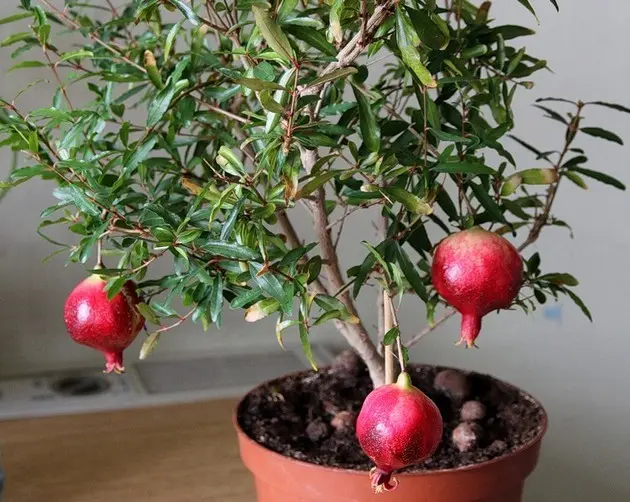
There are several undersized varieties of indoor pomegranate that are highly decorative and intended for growing in a pot:
- “Nana”. Dwarf (up to 70 cm) hybrid form. It begins to bloom in the first year, reaching a height of 40 cm. The flowering is plentiful, the flowers are large, orange-red. The fruits are small (up to 5 cm in diameter), from several dozen flowers on a bush no more than 10 ovaries are formed.
- “Baby”. The shortest (up to 50 cm) indoor variety. The shrub is very decorative, especially during the flowering period. The flower of this pomegranate is large, bright red. Flowering begins in the middle of summer, and by the beginning of autumn, 4-5 rather large fruits ripen on a hedgehog bush.
- “Carthage”. The most abundantly flowering dwarf pomegranate. It can reach a height of 1 meter, the bush is compact, dense, well leafy. Pomegranate flower – bright red, semi-double. The fruits are small (4-5 cm in diameter), burgundy-red.
Methods of reproduction
The most common ways to propagate a pomegranate are cuttings and seed material (seeds or seeds). It should immediately be clarified that for planting in the garden it is easier to purchase ready-made seedlings in nurseries, since they are already grafted with varieties that guarantee abundant fruiting and high taste characteristics. If you want to grow a garden plant with your own hands, then cuttings will be the most acceptable way, since the seed method does not allow you to preserve the taste of the variety.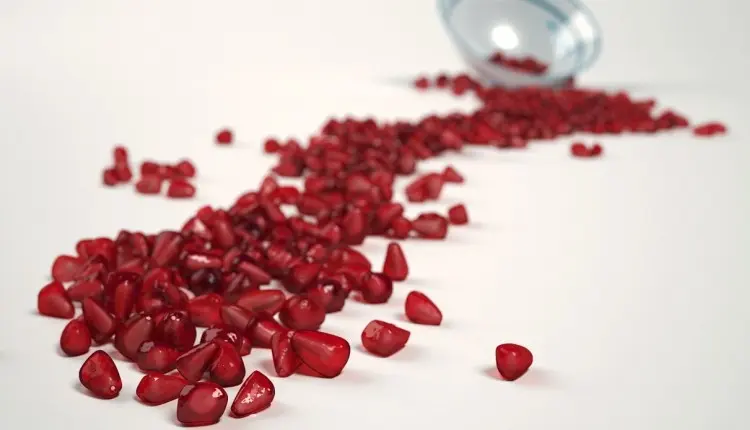
If the main goal is to grow a decorative form of pomegranate, then you can plant a pomegranate tree at home using seeds or seeds.
Here the question may arise: what is the difference between bones and seeds? Seeds are formed in the pomegranate flower when it fades. They can be collected and planted in the soil. Of course, pomegranate, which was grown from seeds, grows more slowly, and the percentage of germination is lower than when grown from seed.
Bones can be taken from grains of fresh fruit. If planting will be done immediately, then it is not necessary to clean the bones from the pulp. If later, then the material must be separated from the pulp, washed and dried a little to prevent rotting. Dried bones, before planting a pomegranate in a pot at home, will need to be pre-soaked in a root-stimulating solution. Then, sow the seeds in the prepared substrate, distributing them evenly over the surface and sprinkling a 1,5-2 cm layer of soil. Until the seeds germinate, it is necessary to maintain soil moisture. When the sprouts reach a height of 3-4 cm, they can be dived into separate pots.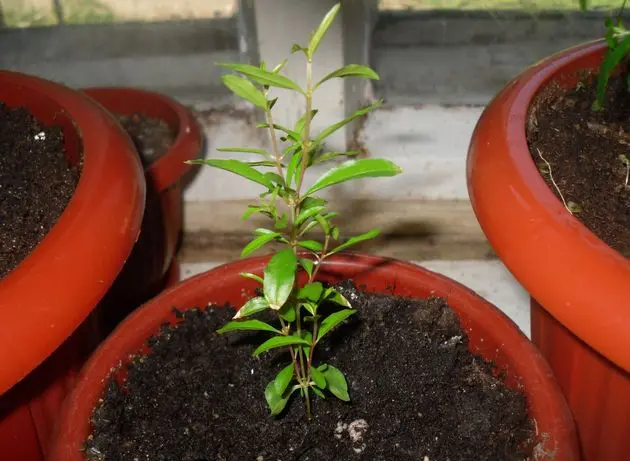
Now in detail about how to plant a pomegranate from a cutting at home:
- at the end of spring, from annual young shoots, cut blanks about 20 cm long with 3-4 buds (you can use root shoots);
- put the cuttings for a day in a solution that stimulates root formation;
- prepare the soil (add sand, peat, organic fertilizers to the soil) and moisten well;
- deepen the prepared cuttings into the soil so that 1 kidney remains on the surface;
- each cutting needs to be provided with a film shelter (you can use a plastic bottle);
Cuttings should be planted in warm soil, the temperature of which is not lower than + 12 ° C. If all the conditions have been met, in about a month the cuttings will begin to take root – this will become noticeable by the growth of the kidney, and after another month the seedlings can be transplanted.
Planting in the garden
Pomegranate is a southern plant, so growing it in the garden only makes sense if you live in a region with a subtropical climate, on the coast or in the steppe area. Of course, there are relatively winter-hardy varieties that can grow and bear fruit not only in the subtropics, but all the same, if the winter temperature has a minus sign, then the pomegranate growing in the garden will require maximum effort and care from the gardener.
The pomegranate tree is not demanding on the composition of the soil. In nature, it successfully grows on stones, poor, even saline sandy soil. In addition, an adult plant perfectly tolerates drought.
In order for a pomegranate planted in the garden to feel comfortable, you need to try to create conditions close to natural for it: prepare loose soil with good drainage, plant it in a sunny place, water it from time to time. Location in the sun is the main condition for obtaining large and sweet fruits.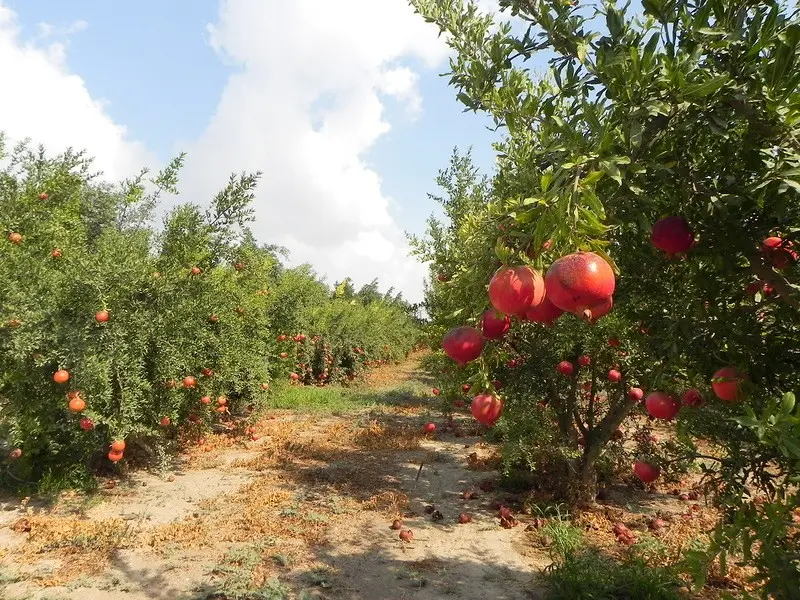
A landing hole for a pomegranate is dug and prepared in the same way as for other fruit trees. The average size of the pit is 60×70 cm with a depth of at least 50 cm. But these parameters are individual for each tree, as they depend on the size of the rhizome of the seedling. At the bottom of the pit (about a quarter), a layer of fertilizers (humus, compost) is laid, sprinkled with a layer of earth. Next, a seedling is placed in the pit, the roots are straightened, and gently covered with earth, slightly shaking the tree so that voids do not form in the soil. In conclusion, the seedling is well watered, if desired, the trunk circle is mulched.
Growing conditions and tree care
As already mentioned, the main thing for a pomegranate is good lighting and warmth. The tree begins to unleash its leaves in spring at a temperature of +12°C, and at the same temperature in autumn it begins to shed them and prepare for dormancy. Flowering begins at a temperature of +18°C, and the fruits ripen within 5-6 months, depending on the variety, by the end of October – mid-November. You need to understand that if snow is already falling in your region in November, then you should not experiment, since a pomegranate grown in such conditions will still not bear fruit.
Growing in a dry climate, the tree needs watering, especially during flowering and ovary formation. If the flowering pomegranate does not have enough moisture, the flowers may crumble. The same thing happens with the ovary. During fruit ripening, watering is reduced, since excess moisture can lead to cracking of the peel. As for low temperatures, spring frosts are not terrible for the pomegranate tree, since the pomegranate blooms quite late, but autumn frosts can cause significant harm to the culture, therefore, in our latitudes, pomegranates need to be thoroughly covered for the winter, and not only the roots, but also the crown of the tree .
An adult fruiting pomegranate, the care of which involves the application of fertilizers, is responsive to mineral and organic top dressing. At the beginning of summer, the tree should be fed with a complex mineral mixture, and during the summer it is recommended to apply liquid chicken manure by watering every two weeks. In autumn, before wintering, potash and phosphorus fertilizers (superphosphate, potassium salt) are scattered around the tree, and the trunk circle is covered with a layer of humus.
Tree formation and preparation for winter
Crown formation is a mandatory step in the care of both home and garden pomegranates. Planned pruning is carried out once in the spring, or after harvesting. First of all, damaged, dried branches, as well as small ones, leading to thickening of the tree, are completely cut out. Then you should remove all root shoots, processes formed on the trunk.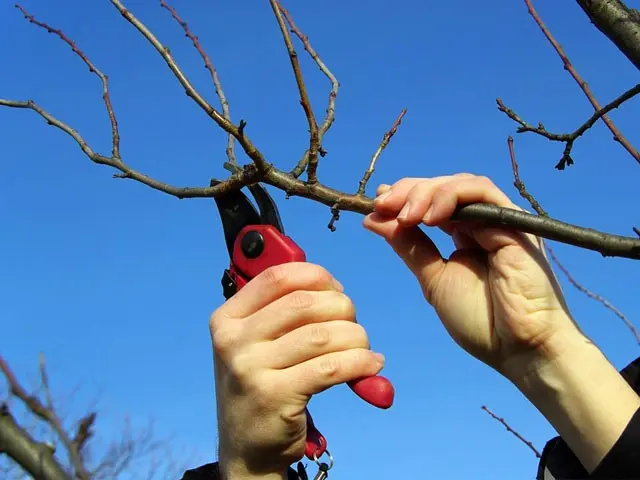
For good fruiting on a tree, it is recommended to leave 5-6 main shoots. With this form, the bush is easier to cover for the winter. Like any fruit tree, pomegranate ages, so every 20-25 years it needs a thorough rejuvenating pruning.
Cultivation at home
Growing pomegranate at home is a very pleasant process in all respects. Watching how a rapidly growing bush is densely covered with bright orange-red flowers, from which miniature fruits are then formed, is a pleasure not only for the grower, but for all households. In addition, caring for indoor pomegranate is not difficult at all.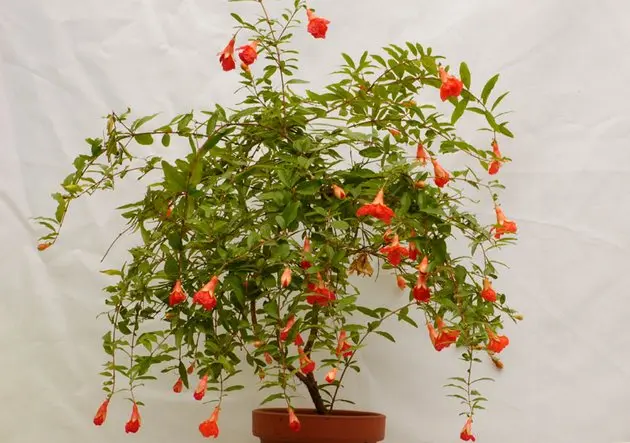
Its main requirement is good illumination and a temperature not lower than + 20 ° C, therefore it is better to put a pot with a tree on the windowsill on the south side. And the rest of the care at home consists of the following activities:
- you need to water the tree as the soil dries up, during the flowering period, watering should be more intense, when the fruits ripen – moderate, and very rare closer to winter;
- until the age of three, homemade pomegranate should be transplanted annually into a larger pot, then transplantation is carried out at intervals of 1 time in 2-3 years;
- for abundant flowering, the bush is fed 1 time in 2-3 weeks with a mineral mixture;
- in autumn, after fruit ripening, the tree should be cut and placed in a cool place (+ 12 ° C) – from December to early February, the pomegranate has a dormant period.
Diseases and pests: control and prevention
The pomegranate is not very susceptible to diseases or pests, but since the proximity to other fruit crops always carries a threat of infection, every spring it should be treated with a solution of a complex insecticide, for example, Bordeaux liquid, for prevention purposes. This drug will protect the pomegranate from fungal diseases (gray rot, leaf spot), and will also serve as a prophylaxis against aphids and spider mites.
If these pests still attacked the tree, then you can get rid of them with the help of tobacco dust or tobacco decoction (400 g / 10 l of water, leave for 2 days), as well as a decoction of walnut leaves (50 g of leaves / 1 l of water, leave for XNUMX hours). ). The most dangerous enemy of the pomegranate is the pomegranate codling moth. These are caterpillars that crawl inside the fruit and eat unripe seeds, which leads to the fall of the ovary and the death of the crop. To avoid the spread of codling moths, you need to regularly inspect the tree, immediately remove and burn diseased parts of the plant.
Video “Care”
From the video you will learn how to care for a pomegranate.










